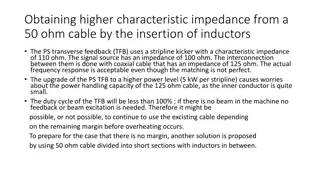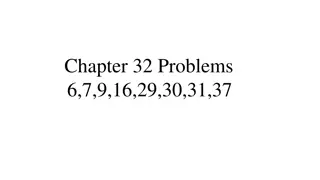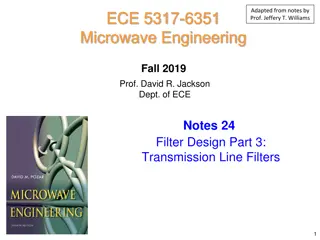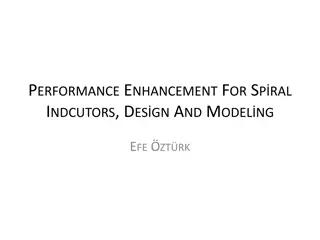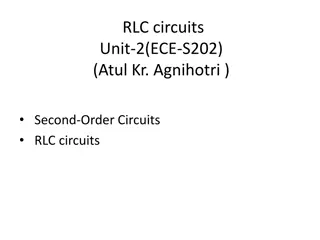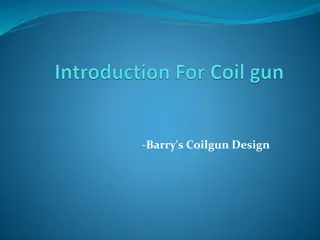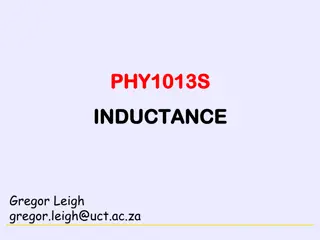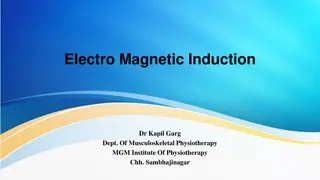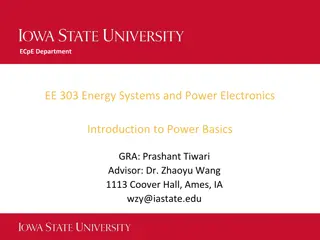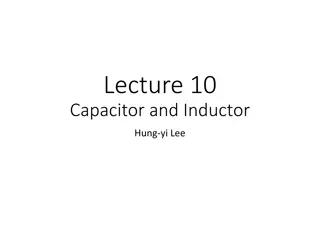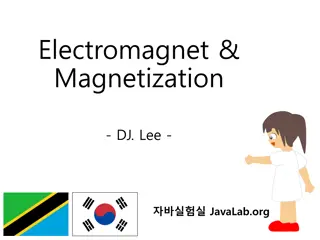Inductance in Electrical Circuits
Inductance in electrical circuits is a crucial concept defined by Faraday's law. It measures the opposition to changes in current, with inductors storing energy in their magnetic field. Mutual inductance and LC circuits further showcase the interconnectedness of inductance in electronic systems.
2 views • 8 slides
Increasing Impedance with Inductors in Transmission Lines
The concept of increasing impedance in a transmission line using inductors is explored in this technical discussion. The use of inductors to raise the characteristic impedance of a cable is illustrated, along with considerations for cable division and filter types. The benefits of Chebyshev filters
0 views • 15 slides
Problems and Solutions in Electromagnetism
This content covers various problems and solutions related to electromagnetism, including calculating induced emf in coils, determining magnetic flux, exploring inductors and solenoids, analyzing energy associated with magnetic fields, and more. Detailed explanations and visual aids are provided for
1 views • 9 slides
Microwave Filter Design Using Transmission Lines
Explore the design of microwave filters using transmission lines, starting with lumped-element designs and transitioning to transmission line approximations. Learn how to realize series inductors and shunt capacitors using narrow and wide sections of microstrip lines. Discover techniques such as Ric
0 views • 28 slides
Impedance and Phasor Diagrams in AC Circuits
Resistive elements in AC circuits exhibit zero phase shift between current and voltage due to their angles. Inductors introduce inductance when connected to AC sources, generating magnetic flux that affects conductor charges. Faraday and Lenz's laws explain induced voltage and current direction base
1 views • 18 slides
Enhancing Spiral Inductors: Design, Modeling, and Performance Optimization
Understanding the importance of inductor parameters like inductance value, self-resonance frequency, and quality factor, this content explores loss mechanisms in inductors and ways to improve their quality. It delves into topics such as reducing phase noise in oscillators, minimizing insertion loss
1 views • 17 slides
Second-Order RLC Circuits in Electronics
Explore second-order RLC circuits in electronics, characterized by second-order differential equations and involving resistors, inductors, capacitors, and voltage sources. Learn about initial and final values of voltage and current, applications in filters, and the differential equations governing t
0 views • 13 slides
Coilguns: A Comprehensive Overview of Coilgun Design and Operation
Coilguns, also known as Gauss guns, accelerate pieces of iron or steel using electromagnetic coils, creating a powerful magnetic field. This overview covers the principles behind coilguns, including magnetic materials, solenoid physics, energy storage in capacitors, and the role of inductors in damp
0 views • 26 slides
Magnetism and Inductance in Physics
Explore the concepts of magnetism, inductance, and inductors in physics, including circuit diagram symbols, energy storage, calculations in RL circuits, and determining inductance. Learn about the differences between inductors and capacitors, as well as the properties and applications of solenoids.
1 views • 14 slides
Natural Response in Electrical Engineering
In this lecture on Introduction to Electrical Engineering, the concept of natural response in circuits involving inductors and capacitors is explored. The process of energizing the components to a steady state, letting the circuit settle naturally, and analyzing the state of inductors and capacitors
0 views • 37 slides
Introduction to Capacitors and Inductors
This chapter covers the basics of capacitors and inductors in electronics, including their properties, uses, and different types. Learn about how capacitors store charge and how inductors store energy in a magnetic field. Explore the world of passive components and their role in electronic circuits.
0 views • 38 slides
EE 202 Electric Circuits: Course Overview and Schedule
Dr. Anmar Arif, Assistant Professor in Power Systems, presents EE 202 Electric Circuits course for the first semester of 2023-2024. The course covers circuit analysis involving dependent sources, operational amplifiers, energy storage elements, and more. Students will delve into topics such as coupl
0 views • 19 slides
Electromagnetic Induction Explained: Production of Voltage & Current
Electromagnetic induction is the process of generating an electromotive force in a conductor within a changing magnetic field. This phenomenon, first discovered by Michael Faraday, has various practical applications in electrical components such as inductors and transformers, as well as in devices l
0 views • 32 slides
Sinusoidal steady state problems
This content delves into the assumptions and consequences of sinusoidal steady-state conditions in electrical circuits. It covers the basics of voltage and current sources, phase and amplitude relations for resistors, capacitors, and inductors, and summarizes amplitude and phase relations in a conci
0 views • 56 slides
Transient Circuit Analysis: Capacitors and Inductors
This content delves into the fundamental properties and behaviors of capacitors and inductors in electrical circuits. It covers how these components store and release energy, their I/V relationships, properties in steady-state conditions, instantaneous changes, and power and energy considerations. T
0 views • 18 slides
Introduction to Power Basics in Energy Systems and Power Electronics
Delve into the fundamental concepts of power basics, phasor analysis, mathematical operations, time domain representation, and phasor domain representation in the context of energy systems and power electronics. Explore the relationship between complex numbers, exponential forms, polar forms, and re
0 views • 30 slides
Analysis of Passive Components in Integrated Circuits and Polysilicon Resistors
Explore the significance of passive components like resistors, capacitors, and inductors in integrated circuits. Learn about the quality parameters, layouts, and characteristics of integrated resistors, along with the intricacies of polysilicon resistors for microelectronic system design.
1 views • 18 slides
Understanding Alternating Current Circuits and Reactance
Explore the world of AC circuits and electromagnetic waves, learn about resistors, capacitors, inductors, reactance, and their applications. Understand how current and voltage behave in different circuit components. Discover the relationships between current and voltage in capacitive and inductive c
0 views • 14 slides
Understanding Capacitors and Inductors in Dynamic Circuits
Explore the characteristics, applications, and behavior of capacitors and inductors in dynamic circuits, including comparisons, power consumption, energy storage, and practical applications like defibrillators. Learn about series and parallel configurations of capacitors and gain insights into their
0 views • 36 slides
Impedance and Ohm's Law in AC Circuits
Explore the mathematical relationships between AC voltage and current in resistors, capacitors, and inductors. Learn about phase relationships and adaptations of Ohm's Law for capacitors and inductors. Derive formulas for impedance and admittance of components for AC circuits.
1 views • 66 slides
Understanding LC Circuit Analysis and Harmonic Motion in Physics
Explore the concepts of LC circuit analysis and harmonic motion in this detailed lecture, covering topics such as damped oscillations, resonance, and energy storage in capacitors and inductors. Learn about the analogy between LC circuits and mass on a spring, and delve into the equations of motion f
0 views • 32 slides
Explore Electromagnetism and Magnetization Techniques
Discover the fascinating world of electromagnetism and magnetization through a series of practical experiments and demonstrations. Learn how to create electromagnets using everyday materials, differentiate between electromagnets and inductors, figure out polarity using compasses, make permanent magn
0 views • 10 slides
Numerical Integration in Ordinary Differential Equations
Explore numerical methods for integrating ordinary differential equations (ODEs) with lecture notes covering one-step methods like Forward Euler, Backward Euler, and the Trapezoidal Rule. Understand how these methods are used to solve initial value problems (IVPs) when analytic solutions are not ava
0 views • 29 slides
S-Domain Analysis in Network Function Lectures
Explore complex frequency analysis, impedance inductors for AC circuits, complete response concepts, and more in this lecture on network functions and S-domain analysis by Hung-yi Lee.
0 views • 42 slides
Understanding Inductance in Electrical Engineering
Explore the concept of inductance in electrical circuits through illustrations and explanations of magnetic flux, right-hand rules, solenoids, and toroidal inductors. Learn how inductance is defined, calculated, and applied in practical scenarios.
0 views • 30 slides
Understanding AC Power, Phasor Analysis, and Impedance in Electrical Circuits
Dive into the world of AC power, phasor analysis, and impedance in electrical circuits. Learn about phasors, RMS values, impedance effects of resistors, inductors, and capacitors, as well as complex power concepts like apparent power and power factor.
0 views • 9 slides
Ham Radio Technician Class Exam Preparation Tips
Get ready for your Ham Radio Technician Class exam with helpful study hints, explanations of electronic and electrical components, and practice questions. Join the Hi-Landers Ham Class instructed by Rich Bugarin W6EC. Learn about resistors, capacitors, inductors, fuses, switches, and more. Enhance y
0 views • 105 slides
AC Circuit Experiment with Impedance and Filters
Learn about AC circuits with capacitors and inductors, high-pass and low-pass filters, and how to analyze RC and RL circuits. Understand the behavior of capacitors, resistors, and inductors in AC circuits through practical experiments. Explore how voltage and current vary with frequency in different
0 views • 12 slides
Understanding Memristors in Electronics
Explore the concept of memristors and their significance in electronics, bridging the gap between resistors, capacitors, and inductors. Learn about memristance, unique properties, implementation, and their analogy as a "4th fundamental element" in electronic circuits.
0 views • 14 slides
Understanding Electrical Circuits: Practical Examples and Calculations
Discover how to analyze resistor networks, calculate total resistance, current, power, and more using MultiSim, Excel, and manual calculations. This comprehensive guide covers series, parallel resistors, capacitors, inductors, RC and RL circuits, providing step-by-step examples and simulations.
0 views • 18 slides
Ferrite Core Inductors in ECE Academic Lab Slides by Zachary Chan
Explore the advantages of ferrite core inductors over iron core, including reduced core losses and applications in high frequency circuits. Learn about soft ferrite vs. hard ferrite and their respective uses in inductors. Discover the benefits of ferrites in various electronic applications such as s
1 views • 4 slides
Interconnect Modeling with Lumped Elements: Basics and Impedance Fundamentals
Explore the fundamentals of interconnect modeling using lumped elements in digital system design, covering modeling techniques, impedance characteristics of resistors, capacitors, and inductors, and understanding the importance of impedance in system analysis. Enhance your knowledge of circuit model
0 views • 26 slides
Passive Components in Integrated Circuits: Resistors, Capacitors, and Inductors
Explore the role of passive components like resistors, capacitors, and inductors in integrated circuits. Discover the importance of quality parameters, parasitic components, and polysilicon resistors in microelectronic system design.
0 views • 19 slides

